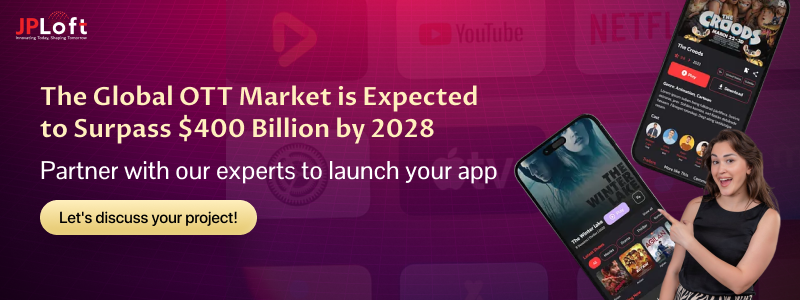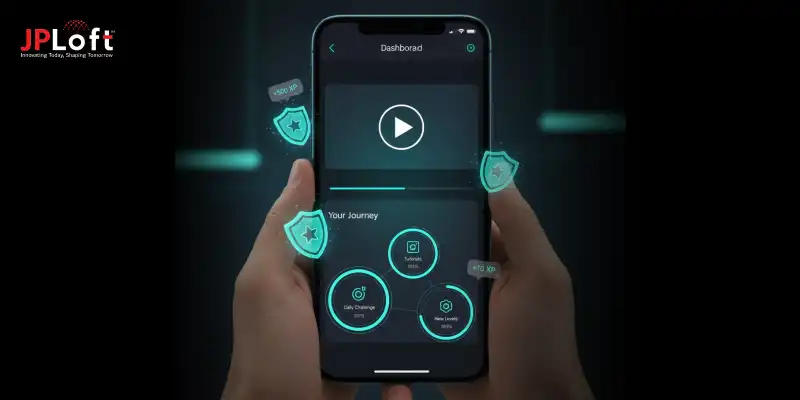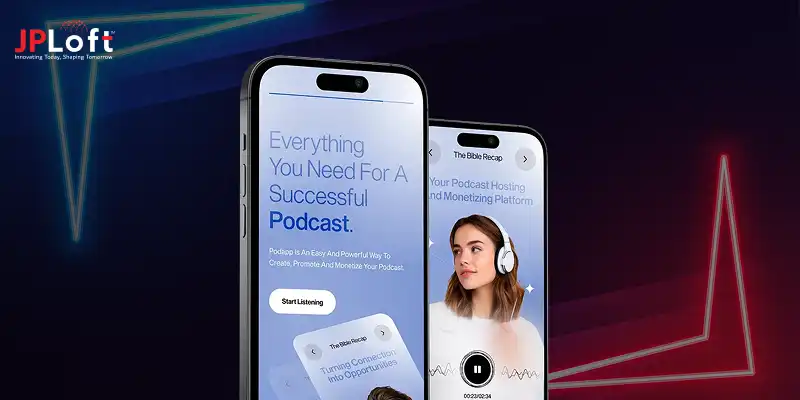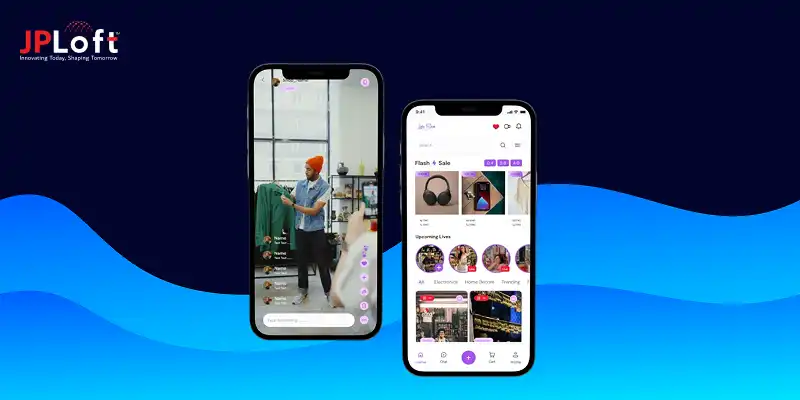Key takeaways:
With user demand soaring and global revenue expected to hit $476 billion by 2027, OTT platforms are dominating the digital space.
To develop an OTT app, you need to follow proper steps for UI/UX design, backend development, and testing. Every phase matters when you create an app that performs well and scales efficiently
Some must-have features of OTT apps include multi-device streaming, personalized recommendations, offline access, secure payments, and real-time analytics.
OTT is different from cable or satellite TV, OTT offers flexible content consumption, cross-platform reach, and user-driven control, anytime, anywhere.
Some common challenges during OTT app development is Data privacy, content moderation, and monetization are key challenges, while AI-based recommendations, regional content, and gamified experiences lead 2025’s trends.
As a leading video streaming app development company, JPLoft offers custom OTT solutions with powerful features, fast deployment, and user-first design.
If you're looking for a complete OTT app development guide, you're in the right place. With the global OTT market expected to surpass $400 billion by 2028, it's the perfect time to create your own OTT platform and tap into the booming demand for on-demand streaming.
Whether you're a startup or an established brand, understanding the steps to build an OTT app from scratch is key to launching a successful product.
In this blog, we’ll walk you through every stage from ideation to launch, in a simple, step-by-step manner. So, if you’ve ever dreamed of launching the next Netflix or Hotstar, let’s get started.
What Exactly Is an OTT App?
An OTT (Over-the-Top) app is a platform that delivers video content directly to users via the internet, no traditional cable or satellite TV needed. Think of apps like Netflix, Hotstar, or Amazon Prime Video.
These platforms allow users to watch movies, shows, live sports, and more anytime, anywhere, using just a smartphone, smart TV, or computer. OTT apps are changing how we consume entertainment by offering personalized content, subscription flexibility, and ad-free viewing.
Behind the scenes, video streaming app development involves building features like user profiles, content libraries, payment systems, and smooth playback.
Whether you're a content creator, media company, or startup, launching your own OTT app can help you reach a wider digital audience and create a strong brand presence in the booming online streaming space.
Market Statistics of OTT Apps
Before you dive into building your OTT platform, it’s important to understand the booming market you’re entering. These stats reveal just how massive and promising the OTT landscape has become in recent years.
Let’s understand it in detail.
-
According to Statista, the OTT market revenue is projected to grow at a CAGR of 6.31% between 2025 and 2030, reaching approximately US$466.82 billion by 2030.
-
From content recommendations to dynamic thumbnails and voice-assisted search, OTT platforms are increasingly leveraging artificial intelligence (AI) and machine learning (ML) to deliver hyper-personalized viewing experiences that improve user engagement and retention.
-
A study by Straits Research shows that the global OTT market was valued at USD 276.02 billion in 2021 and is projected to grow to USD 2,838 billion by 2030, with a CAGR of 29.55% during the 2022–2030 forecast period.
-
Viewers are moving away from generic content toward culturally relevant, language-specific, and interest-based shows. This shift is pushing platforms to invest in diverse content libraries and micro-targeted content strategies.
-
Market Research Future reported that the OTT market is expected to expand from USD 71.11 billion in 2025 to USD 266.31 billion by 2034, registering a CAGR of 15.80% throughout the forecast period.
These numbers clearly show the massive potential of OTT apps in today’s digital-first world. Whether you’re targeting niche content or global audiences, now is the time to invest in building your streaming app.
Reasons to Develop an OTT App in 2025
2025 is shaping up to be a golden year for digital entertainment, and investing in OTT app development can open up massive growth opportunities.
Here's why you shouldn’t miss out:
-
Explosive Market Growth: With millions cutting the cord, the OTT industry is booming. Now is the best time to create your own OTT platform and reach a global audience.
-
Low Entry Barrier, High ROI: You no longer need a massive studio or cable network to start an online video streaming business, just the right idea and platform.
-
Customizable Features: From content control to monetization, you can build OTT platform solutions tailored to your brand and audience.
-
Future-Ready Business Model: Investing in OTT now means you’re aligning with a digital-first world where streaming is the primary source of entertainment.
Whether you're a content creator or an entrepreneur, OTT is the future. So what are you waiting for? Tap into the digital streaming revolution today.
Different between OTT vs Traditional Methods
With the rapid growth of video streaming apps, businesses and creators are shifting away from traditional broadcasting.
Here's how OTT platforms stand apart from conventional methods like cable and satellite TV:
|
Aspect |
OTT Platforms |
Traditional Methods (TV/Cable) |
|
Content Delivery |
Delivered via the internet using apps and devices |
Broadcasted via satellite, cable, or antennas |
|
Accessibility |
Watch anytime, anywhere, on-demand |
Limited to schedule and location |
|
User Control |
Full control over playback, pause, skip, and resume features |
No playback control once content airs |
|
Personalization |
Personalized recommendations, user profiles, and watch history |
One-size-fits-all content with no personalization |
|
Device Compatibility |
Accessible on smartphones, tablets, smart TVs, and web browsers |
Mostly limited to TV screens |
|
Monetization Options |
Subscription, ads, pay-per-view, freemium |
Mostly ad-based or fixed subscription via cable providers |
|
Live Streaming Capability |
Supports live video streaming for events, sports, and news |
Live only through fixed TV programming slots |
|
Analytics & Insights |
Offers real-time analytics and viewer behavior insights |
Very limited data on audience engagement |
|
Cost to Maintain |
Flexible maintenance depending on infrastructure and features |
High cost of broadcasting and equipment maintenance |
|
Scalability |
Highly scalable with cloud integration and global reach |
Limited by physical network and infrastructure |
As OTT technology continues to evolve, the flexibility, control, and scalability it offers make it the go-to choice over traditional viewing formats, especially for modern audiences and businesses alike.
Core Features Every OTT App Should Have
To create a successful OTT platform that meets modern user expectations, your app must be loaded with the right set of features. These video streaming app features not only enhance the user experience but also ensure smooth performance, better engagement, and long-term scalability.
Here are the essential features your OTT app must include:
-
User Registration & Profile Management: Provide users with a quick sign-up process using email, phone, or social media. Personalized user profiles help tailor content preferences and maintain watch history.
-
Advanced Search & Filter Options: A searchable content library with smart filters (genre, language, release year, etc.) makes it easy for users to find what they love without endless scrolling.
-
High-Quality Video Player: Support for HD, Full HD, and even 4K playback, with adaptive bitrate streaming to ensure buffer-free performance based on internet speed.
-
Cross-Platform Compatibility: Enable seamless access across Android, iOS, smart TVs, and web browsers so users can switch devices without losing progress.
-
Offline Viewing: Let users download videos for offline viewing, a highly demanded feature for people with limited or unstable internet access.
-
AI-Based Personalized Recommendations: Use smart algorithms to analyze user behavior and recommend shows or movies tailored to their interests. If you want to create an AI app for video streaming, this feature is essential to enhance engagement, drive content consumption, and boost user retention.
-
Real-Time Push Notifications: Keep users engaged with alerts on new releases, recommendations, live events, offers, or subscription updates.
These features are the foundation of a modern, user-centric OTT application. By implementing these thoughtfully, you ensure your platform is not just functional but also competitive in today’s fast-growing digital entertainment market.
Step-by-Step OTT App Development Process
Launching your own OTT platform is more than just uploading videos, it’s about delivering seamless streaming, engaging interfaces, and personalized experiences to your audience.
Whether you're aiming to develop an OTT app like Netflix or create a niche streaming service, understanding the process is key to success.
Here’s a complete breakdown of the steps to build an OTT app from scratch:
Step 1: Market Research & Define Your Niche
Before jumping into OTT application development, it’s essential to understand your target audience, industry trends, and competitors. Who are your viewers and what type of content do they enjoy, like movies, tutorials, sports, or education.
Also, explore the trends in video streaming apps to find gaps and opportunities. For example, niche platforms like CuriosityStream (for documentaries) or Crunchyroll (for anime) succeeded by focusing on specific interests.
Identifying your unique niche early will guide your design, content, and marketing decisions.
|
Niche |
Example |
Target Audience |
|
Movies & Series |
Netflix |
General entertainment |
|
Documentaries |
CuriosityStream |
Knowledge seekers |
|
Sports |
ESPN+ |
Sports fans |
|
Education |
Skillshare |
Students, learners |
|
Kids & Family |
Disney+ |
Children & parents |
|
Regional Content |
Aha |
Local language viewers |
|
Anime/K-Drama |
Crunchyroll |
Anime, drama lovers |
Step 2: Plan Features & Functional Requirements
Before you develop an OTT app, it’s important to plan the core features your platform will need. For users, include smooth sign-up, a searchable video library, high-quality video playback, offline downloads, multi-device support, and secure payment options.
Add-ons like personalized recommendations, watch history, and user reviews make the app more engaging. On the backend, ensure your admin panel supports easy content uploads and performance tracking.
If you're planning to stream real-time events or news, integrate live video streaming features early on. To get it right from the start, it’s smart to hire dedicated developers who can tailor features to your specific goals.
|
User Features |
Admin Features |
|
Easy sign-up/login |
Content management |
|
Video library & HD playback |
Analytics & reporting |
|
Multi-device support |
User & subscription control |
|
Offline downloads |
Monetization tools |
|
Secure payments |
Live stream management |
|
Personalized recommendations |
Push notifications |
Step 3: UI/UX Design – Make It User-Friendly
Design is everything when it comes to engagement. A clean, intuitive interface keeps users coming back. Focus on smooth navigation, minimal clicks, and personalized experience. Don’t forget to make it visually appealing and responsive across devices.
The process starts with app wireframing and app prototyping, helping you visualize the layout, flow, and user interactions before development begins. This ensures a smoother, more user-centric final product.
Want to go deeper? Here’s a helpful read on how to design a video streaming app that users will love.
Remember, the UI/UX phase sets the stage for both the user journey and brand impression. This is especially crucial in a custom OTT app, where every detail should reflect your brand.
|
UI/UX Element |
Purpose |
|
Intuitive Navigation |
Helps users find content quickly with minimal effort |
|
Personalized Dashboard |
Offers customized suggestions and watchlists for user retention |
|
Clean Visual Layout |
Enhances readability and makes browsing more enjoyable |
|
Responsive Design |
Ensures smooth experience across smartphones, tablets, and TVs |
Step 4: Select the Right Tech Stack
To build an OTT app that’s fast, scalable, and reliable, choosing the right technology stack is key. For the frontend, React Native or Flutter work well for cross-platform OTT app development, while backend frameworks like Node.js or Django handle data and user interactions smoothly.
Databases like MongoDB or MySQL manage your content and user info, and cloud services such as AWS or Google Cloud ensure fast video delivery. Streaming protocols like HLS or RTMP help deliver high-quality content across devices.
Also, don’t forget about video streaming app security, features like DRM, encryption, and token-based access are essential to protect your content and user data.
|
Component |
Recommended Technologies |
Purpose |
|
Frontend Framework |
React Native, Flutter |
Cross-platform mobile app development |
|
Backend Framework |
Node.js, Django |
Handles logic, user interactions, APIs |
|
Database |
MongoDB, MySQL |
Stores user data, content metadata |
|
Cloud Services |
AWS, Google Cloud, Microsoft Azure |
Hosting, storage, fast and scalable delivery |
|
Streaming Protocols |
HLS (for on-demand), RTMP (for live streaming) |
Deliver smooth video playback |
Step 5: Test Thoroughly Across Devices
Before launch, app testing across different devices is crucial. Make sure it performs well under heavy traffic, streams smoothly on all internet speeds, and looks consistent across mobiles, tablets, and TVs.
Don’t forget to check the subscription flow and fix any security issues. Gathering feedback from beta users can also help you polish the experience.
The goal is to launch a stable, high-quality app that competes with the best video streaming apps out there. A well-tested app not only builds trust but also reduces the chances of negative user reviews and uninstalls after launch.
|
Testing Type |
Purpose |
|
Functional Testing |
Ensure all app features work as intended, including login, search, and playback. |
|
Cross-Device Testing |
Verify compatibility across phones, tablets, TVs, and browsers. |
|
Network Testing |
Ensure smooth playback on 2G, 3G, 4G, and Wi-Fi networks. |
|
Security Testing |
Identify vulnerabilities, test DRM, encryption, and secure payment flows. |
|
Beta Testing |
Collect real-user feedback to find and fix overlooked issues. |
Step 6: Launch & Distribute Your App
Once testing is complete, it’s time to launch your OTT app to the world. Make sure to submit an iOS app to the App Store and publish app to Google Play Store following their respective guidelines.
Also, don’t forget to release it on other platforms like Smart TVs and the web to maximize your reach. Optimize your app listings with the right keywords, engaging screenshots, and clear descriptions to attract downloads.
After the launch, focus on marketing, run social media ads, collaborate with influencers, and promote your content through teaser trailers or behind-the-scenes videos.
|
Platform |
Action |
|
Google Play Store |
Publish Android version, follow Google’s policy, optimize ASO for visibility. |
|
Apple App Store |
Submit iOS app, ensure compliance with App Store Review Guidelines. |
|
App Store Optimization (ASO) |
Use relevant keywords, high-quality visuals, and compelling descriptions. |
|
Marketing Strategy |
Run social ads, collaborate with influencers, use trailers & content teasers. |
Step 7: Post-Launch Support & Regular Updates
The real journey begins after launch. Monitor user behavior, track analytics, and gather feedback to keep improving your app experience.
Regular updates with new features, better performance, and fresh content are essential for keeping users engaged and reducing churn. To ensure long-term success, invest in a reliable app maintenance service that can handle bug fixes, updates, and performance monitoring.
Also, focus on building scalable infrastructure for your OTT streaming app development so your platform can smoothly grow with your audience and content library over time.
|
Area |
Key Actions |
|
User Feedback Monitoring |
Collect app store reviews, in-app feedback & social media comments. |
|
Analytics & Performance |
Track user behavior, crash reports, load times, and streaming quality. |
|
Bug Fixes & Issue Resolution |
Fix bugs quickly, address security flaws, and patch vulnerabilities. |
|
Feature Enhancements |
Roll out updates based on user needs and industry trends. |
|
Content Updates |
Regularly add new shows, movies, or exclusive releases to boost engagement. |
By following this step-by-step guide, you’ll be better prepared to launch a platform that’s scalable, secure, and engaging. From video streaming app idea to launch, staying aligned with trends and user expectations is the key to long-term success.
Technology Stack While Developing an OTT App
Choosing the right tools and technologies is a big part of a successful OTT app. Your tech stack decides how your app performs, how easily it can scale, and how smooth the user experience feels.
Below is a table explaining each layer of the video streaming app tech stack that powers modern OTT platforms:
|
Category |
Technologies/Tools |
Purpose |
|
Frontend (User Interface) |
React Native, Flutter, Swift (iOS), Kotlin (Android), HTML5 for web |
Builds the part users see and interact with across devices. |
|
Backend (Server-side) |
Node.js, Django, Ruby on Rails, Express.js |
Handles app logic, user data, and integrates services. |
|
Streaming Protocols |
HLS (HTTP Live Streaming), MPEG-DASH |
Delivers video content smoothly to users, adapting to different bandwidths. |
|
Video Hosting & CDN |
AWS MediaConvert, Wowza, Vimeo, Cloudflare, Akamai |
Stores and distributes videos to reduce buffering and lag. |
|
Database |
MongoDB, PostgreSQL, MySQL, Firebase Realtime DB |
Stores user info, watch history, subscriptions, and more. |
|
Cloud & Storage |
AWS, Google Cloud, Microsoft Azure |
Provides scalable storage, computing, and deployment power. |
|
Payment Integration |
Stripe, Razorpay, PayPal, Apple Pay, Google Pay |
Manages subscription payments and in-app purchases. |
|
Analytics & Monitoring |
Google Analytics, Firebase Analytics, Mixpanel, AppDynamics |
Tracks user behavior and app performance. |
|
Push Notifications |
OneSignal, Firebase Cloud Messaging (FCM), Airship |
Sends alerts for new content, updates, and engagement reminders. |
|
Security Tools |
SSL, DRM (Widevine, FairPlay), AES Encryption, OAuth 2.0 |
Protects content and user data from unauthorized access. |
Choosing the right tech stack is key to building a reliable, fast, and user-friendly platform. So, invest wisely in each layer to ensure your app development journey leads to long-term success.
How Much Does OTT App Development Cost?
The OTT app development cost depends on multiple factors like app complexity, target platforms, UI/UX design, backend infrastructure, and the video delivery system.
On average, building a video streaming app can cost anywhere between $30,000 to $350,000+, depending on the app’s complexity, target audience, and supported platforms.
The cost to build a video streaming app also varies based on your development team's location. Hiring a team from North America may cost significantly more than hiring developers from Eastern Europe or South Asia.
Additionally, real-time features like live chat, watch parties, or content personalization engines will add to the overall cost.
Planning to launch a regional or niche OTT platform similar to Shahid? In that case, the cost to develop a video streaming app like Shahid may also include added expenses for content licensing, language localization, and region-based streaming features
Overall, the final cost depends on your app's vision, scalability goals, and the tech stack you choose for your OTT platform. Below is the detail breakdown of the cost:
|
Component |
Estimated Cost Range (USD) |
Short Description |
|
UI/UX Design |
$4,000 – $15,000 |
Visual design and user journey flow for engaging and intuitive interfaces. |
|
Frontend Development |
$6,000 – $40,000 |
Code that powers the user-facing side of the app across platforms. |
|
Backend Development |
$10,000 – $70,000 |
Server-side logic, database handling, and core system functionality. |
|
Video Streaming Infrastructure |
$8,000 – $50,000 |
CDN setup, adaptive streaming, encoding, and playback support. |
|
CMS & Admin Panel |
$4,000 – $20,000 |
Dashboard for content upload, user management, and performance tracking. |
|
Third-party APIs & Integration |
$3,000 – $15,000 |
Payment gateways, analytics, social logins, and other essential integrations. |
|
Platform Deployment (iOS, Android, Web, TV) |
$6,000 – $60,000 |
Making the app live across selected platforms and ensuring compatibility. |
|
Testing & QA |
$3,000 – $10,000 |
Functional, usability, performance, and device-specific testing. |
|
Post-Launch Support & Updates |
$5,000 – $30,000 (Yearly) |
Bug fixes, upgrades, and feature enhancements after the app goes live. |
These are estimated figures and can vary based on your project needs and goals. Partnering with the best mobile app development company can help you optimize costs while delivering a feature-rich platform.
Turn Views into Revenue: OTT Monetization Models
The success of your OTT app doesn't just rely on great content, it also depends on how you monetize a video streaming app effectively.
If you're planning to create your own OTT platform, exploring the right monetization strategy is essential for long-term growth.
-
Subscription-Based Model (SVOD): Charge users a recurring fee (monthly, quarterly, or annually) for unlimited access to your content library. Ideal if you're planning to create your own OTT platform with consistent, premium content.
-
Ad-Supported Model (AVOD): Let users watch content for free while you earn from advertisements. This model works well when you're targeting mass audiences and looking to monetize your app with minimal user friction.
-
Pay-Per-View (TVOD): Users pay only for the content they want to watch, like movies or live events. This is a great fit if you plan to build an OTT platform focused on exclusive or one-time content.
-
Freemium Model: Offer basic content for free while locking premium features or shows behind a paywall. This model helps attract users quickly while driving paid conversions over time.
-
Hybrid Monetization: Combine two or more models (e.g., ads + subscriptions) to diversify revenue streams. Many businesses following OTT app processing strategies choose this for greater flexibility.
Whether you aim to create an app for niche audiences or build OTT platform features like live streaming or multi-language support, choosing the right monetization strategy is key to long-term success.
Challenges to Build an OTT Platform & How to Solve Them
Building an OTT platform is exciting, but not without its hurdles. From performance issues to scalability, the development challenges of video streaming apps can impact both user experience and operational costs.
Here's a breakdown of common challenges and practical ways to solve them:
► Scalability & Streaming Performance
As your audience grows, your platform needs to handle thousands, possibly millions of users watching simultaneously. Poor scalability can lead to slow loading, buffering, or even app crashes during peak hours.
Solution: Implement adaptive bitrate streaming, leverage CDNs (Content Delivery Networks), and opt for cloud-based services like AWS or Azure to ensure consistent performance across regions.
► Content Licensing & Geo-Restrictions
To keep your content library competitive, you’ll need licensed shows, movies, or exclusive productions. However, licensing varies by country, and acquiring rights for multiple regions can be time-consuming and expensive.
Solution: Start by focusing on region-specific content, then scale globally. Use advanced geo-blocking and compliance tools to ensure content is delivered only where it’s legally allowed.
► Cross-Platform Compatibility
Modern users demand flexibility, they want to watch content on smartphones, tablets, desktops, smart TVs, and gaming consoles. Delivering consistent quality across all these platforms is a major technical hurdle.
Solution: Use a responsive design and build a modular architecture. Frameworks like React Native or Flutter can help speed up development when you’re planning to build an OTT platform for multiple devices.
► Security & DRM Integration
Piracy and content theft are serious concerns, especially if your platform offers premium or exclusive content. Leaks can damage your brand and hurt revenue.
Solution: Protect your platform with multi-level security: implement strong user authentication, integrate DRM (Digital Rights Management), and consider forensic watermarking to trace leaks.
► High Development Costs
The cost to develop an app like YouTube or other major OTT platforms can be steep. From backend architecture to UI design, payment integration, and analytics, each element adds up.
Solution: Start with an MVP approach. Focus on must-have features first, and then scale as your platform grows. This not only keeps costs manageable but helps validate your business model early.
Whether you're planning to create your own OTT platform or want to overcome technical barriers, solving these challenges early can streamline your path to launch and success.
Top Trends in OTT App You Should Know About
OTT platforms are evolving fast and if you’re planning to create your own OTT platform, keeping up with the latest trends is the key to staying competitive.
Let’s explore what’s shaping the future of OTT app:
1. AI-Powered Content Recommendations
Gone are the days of generic suggestions. Today, AI development services help analyze user behavior to recommend shows and movies users are most likely to enjoy, boosting watch time and overall engagement.
2. Voice Search & Smart Assistant Integration
Typing is old-school! Users now expect to search content using voice commands through Alexa, Google Assistant, or Siri, making navigation faster and more convenient.
3. Interactive & Live Streaming Content
Whether it’s live sports, concerts, or reality shows, real-time streaming is on the rise. OTT platforms are integrating chat features, polls, and live reactions to make content more interactive.
4. Offline Viewing & Download Options
One of the most requested features: the ability to download content and watch offline. It’s become a must-have, especially for users in areas with limited connectivity.
5. Multi-Device & Cross-Platform Support
From mobile to smart TVs, users want to stream content on any device, anytime. That's why the OTT app now prioritizes seamless playback across platforms.
Staying aligned with these trends can help you deliver a smart, modern, and user-friendly OTT experience that stands out.
Why Partner with a Professional OTT App Development Company?
Launching a successful OTT platform requires more than just an idea, it demands technical expertise, strategic planning, and reliable execution.
That’s where the support of skilled OTT development professionals becomes crucial.
A] Expertise in Niche Technologies
Professional OTT app developers bring hands-on experience in video streaming architecture, DRM, adaptive bitrate streaming, and cross-platform integration, ensuring your app is future-ready.
B] Expertise in AI for Personalized Experiences
A professional team with strong AI development expertise can integrate intelligent features like content recommendations, viewer analytics, and predictive search. This not only enhances user engagement but also gives your OTT platform a competitive edge in a crowded market.
C] Scalable & Secure Infrastructure
Whether you're catering to 1,000 or 1 million users, a trusted OTT app development company builds infrastructure that scales seamlessly while keeping content safe from piracy or leaks.
D] Ongoing Support & Optimization
You won’t be left on your own after launch. Reliable developers provide post-launch maintenance, regular updates, and performance optimization to keep your platform competitive.
With the right development partner by your side, you can build an OTT platform that’s not just functional, but truly unforgettable.
From Idea to Reality: Why JPLoft Leads in OTT App Development
Turning your streaming app idea into a successful platform demands more than just coding, it requires a tech partner who understands the OTT ecosystem inside out. That’s where JPLoft comes in.
As a leading video streaming app development company, we combine technical excellence with industry insight to build engaging, scalable, and feature-rich platforms.
Whether you need live streaming, adaptive bitrate playback, analytics dashboards, or secure payment integration, we ensure your app is designed for performance and user retention.
From concept validation and UI/UX design to backend development and post-launch support, we offer end-to-end services that bring your OTT vision to life on time and within budget.
With us by your side, you’re not just building an app, you’re building a streaming business.
Final Wrap-Up
OTT platforms are revolutionizing the way we consume entertainment, and launching your own can be a game-changer, if done right. With strategic planning, cutting-edge features, and professional execution, your app can stand out in a saturated market.
Whether you're targeting niche audiences or aiming to build the next global sensation, success depends on how well you execute every stage from ideation to launch to post-launch growth.
If you’re ready to build your streaming platform, team up with experts who understand the landscape. With the right guidance, your vision can become the next big thing in OTT app development.
FAQs
An OTT app lets you reach a wider audience, deliver content directly, and earn through subscriptions or ads. It boosts your brand, offers flexible monetization, and meets the rising demand for digital streaming.
Use a cloud-based backend, implement a CDN for smooth streaming, and regularly test performance to handle growing traffic efficiently.
The cost to develop an OTT app typically ranges from $30,000 to $350,000+, depending on features, platform (iOS, Android, Smart TV), UI/UX complexity, and backend infrastructure. Advanced features like live streaming or AI recommendations can increase the budget.
Yes, popular monetization models include subscriptions (SVOD), ads (AVOD), pay-per-view (TVOD), and freemium models. You can even offer hybrid options based on your audience.
Not necessarily. With cross-platform frameworks or progressive web apps, you can build for multiple platforms with a single codebase. However, for best user experience, native apps often perform better.













Share this blog